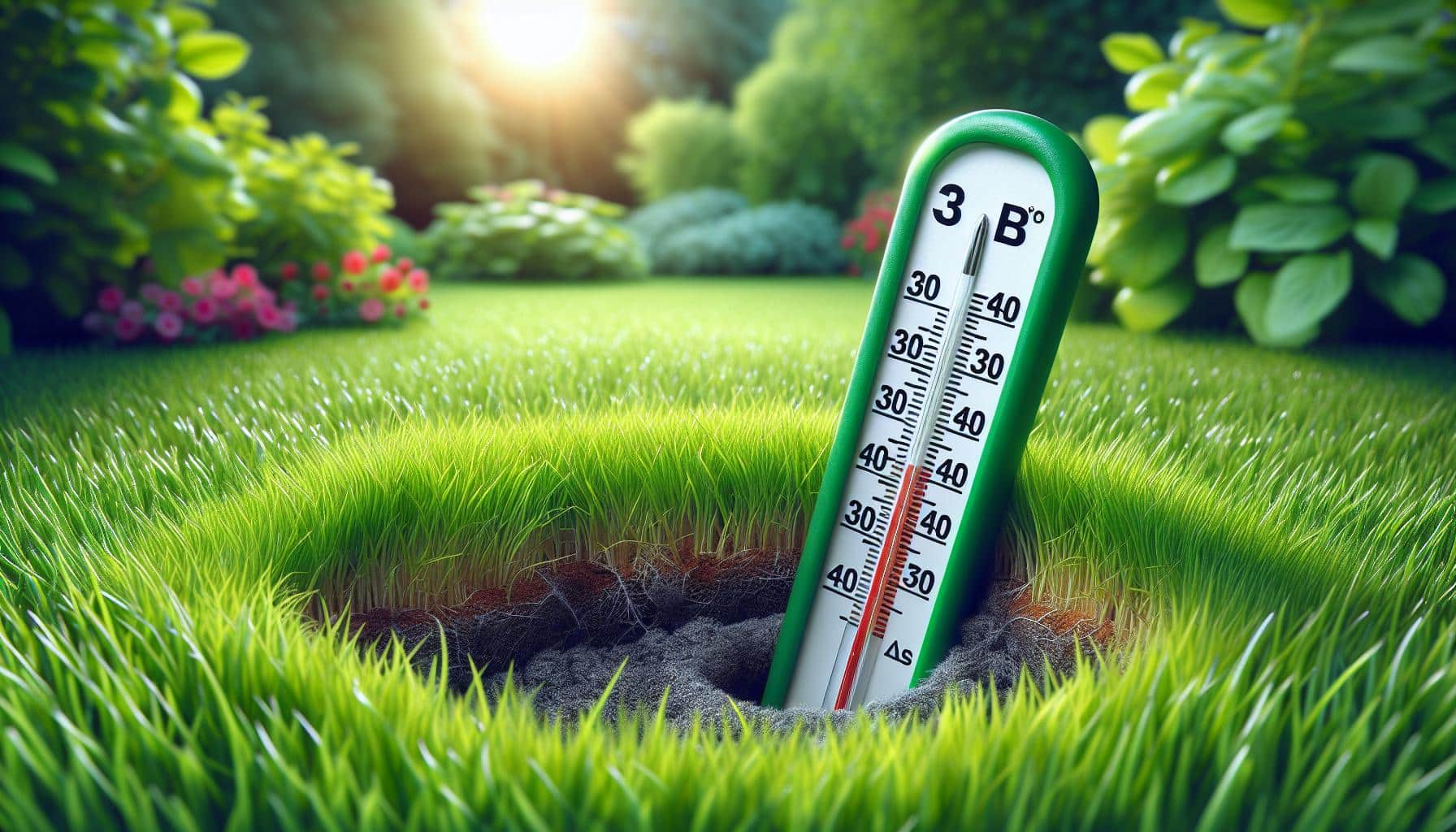
Overseeding your lawn is a game-changer in maintaining a lush, healthy garden. It’s the secret weapon against thinning and weed-infested lawns, ensuring your outdoor space remains vibrant and inviting. But, timing and temperature are everything. Knowing the perfect moment and the ideal soil temperature can significantly impact the success of your overseeding efforts.
The magic number? A soil temperature consistently around 48°F is key for overseeding. This typically falls between March and May in spring or in August or September during fall. Choosing the right time ensures the seeds germinate effectively, setting the stage for a verdant lawn that’s the envy of the neighbourhood.
Importance of Temperature for Overseeding Lawn
When you’re looking to overseed your lawn, understanding the right temperature is crucial. The success of overseeding heavily relies on soil temperature, which plays a significant role in the germination of new grass seeds. Ideally, soil temperatures should range between 50°F and 65°F for optimal germination rates. This temperature range ensures that the seeds can sprout effectively, establishing a robust root system before the harsher weather conditions of winter or the extreme heat of summer.
Air temperature is another critical factor to consider. For successful overseeding, air temperatures should ideally stay between 60°F and 75°F. This range provides a comfortable environment for tender young grasses to thrive, away from the threat of frost and without the stress induced by high heat. It’s this balance that supports your lawn in developing a thick, green, and healthy appearance.
Overseeding during these specific temperature windows maximizes your lawn’s potential for growth. It ensures your efforts aren’t wasted and leads to a lush, vibrant outdoor space.
Remember, timing is everything. Overseeding outside these optimal temperature ranges may result in poor seed germination and growth, leading to a less than satisfactory lawn. So, make sure to monitor both soil and air temperatures closely before beginning your overseeding project.
Ideal Temperatures for Overseeding

When you’re planning to overseed your lawn to enhance its density and appearance, knowing the ideal temperatures for the type of grass you have is crucial. Different grass types thrive in different temperature ranges, so it’s essential to tailor your overseeding efforts accordingly.
Warm-Season Grasses
For warm-season grasses, such as Bermuda, Zoysia, and St. Augustine, the ideal time for overseeding is not during their peak growth phases in the heat of summer, but rather in the late spring or early summer. This strategic timing allows warm-season grasses to establish well before the arrival of cooler temperatures.
The optimum soil temperature for overseeding warm-season grasses should range from 65°F to 75°F. This temperature range encourages effective germination and root development, ensuring that the grass can withstand the intense summer heat and continue thriving.
| Temperature Type | Ideal Range (°F) |
|---|---|
| Soil Temperature | 65°F to 75°F |
When considering overseeding with a cool-season grass type for temporary winter color, target the early fall, as this is when the soil is still warm enough to support germination, but the air begins to cool. Overseeding during this period ensures that the cool-season grass varieties can establish themselves before winter dormancy sets in.
Cool-Season Grasses
For those with cool-season grasses like Kentucky bluegrass, perennial ryegrass, and fescues, the best overseeding results are often achieved in the fall. The soil is still warm from the summer months, but the cooler air temperatures of fall create an ideal growing environment.
The prime soil temperature for overseeding these grass types lies between 50°F and 65°F. This range ensures that the seeds can germinate properly, and the young grass can establish a strong root system before the cold of winter or the heat of summer takes hold.
| Temperature Type | Ideal Range (°F) |
|---|---|
| Soil Temperature | 50°F to 65°F |
A key consideration when overseeding cool-season grasses is timing. You’ll want to start the process at least 45 days before the first expected frost in your area to give the grass sufficient time to mature. Checking soil temperature with a soil thermometer can guide you in choosing the perfect time to overseed for maximum growth potential.
By adhering to these temperature guidelines and timing your overseeding project just right, you’re on your way to creating a lush, healthy lawn that can withstand the challenges of its environment. Remember, the success of overseeding depends not just on the correct seed selection, but also on ensuring that the conditions are ideal for your grass type to thrive.
Managing Temperature Fluctuations

When you’re planning to overseed your lawn, understanding and managing temperature fluctuations is key. Ideally, soil temperatures should be stable to encourage optimum seed germination. But, weather patterns can often be unpredictable, throwing a wrench into your overseeding plans.
First off, monitor local weather forecasts closely in the weeks leading up to your overseeding project. Look for a consistent pattern of suitable temperatures for the type of grass you’re planting. For warm-season grasses, soil temperatures should consistently be between 65°F and 75°F, while for cool-season grasses, aim for soil temperatures of 50°F to 65°F.
It’s also important to avoid overseeding during extreme temperature fluctuations. A sudden cold snap or an unexpected heatwave can hinder seed germination and growth. If such conditions are forecasted shortly after planting, it might be wise to delay your overseeding project.
To mitigate the effects of temperature dips overnight, consider using a light layer of straw or burlap over the seeded areas. This can help maintain a more consistent soil temperature, protecting the seeds during their critical germination phase.
Remember, successful overseeding is not just about choosing the right moment but also about preparing for and managing the whims of the weather. By keeping a close eye on temperature fluctuations and taking steps to protect your seeds, you’ll significantly increase the chances of achieving a lush, healthy lawn.
Conclusion
Overseeding your lawn is a delicate balance that requires keen attention to temperature and weather patterns. By monitoring soil temperatures and preparing for unexpected weather changes, you’re setting the stage for successful seed germination. Remember, the effort you put into timing and protecting your seeds from temperature extremes will pay off in the lushness of your lawn. So, keep an eye on the forecast, use protective measures like straw or burlap when needed, and trust in the process. Your diligence and care will result in a vibrant, dense lawn that’s the envy of the neighbourhood.
Colin Macmillan is a seasoned entrepreneur and the CEO of Riverwood Landscape, a leading landscaping company based in Canada. He has been at the helm of the company since leaving high school, demonstrating his strong leadership skills and business acumen.
Colin’s expertise lies in various aspects of landscaping, including lawn care, interlocking, sod installation, and commercial maintenance. His hands-on approach and dedication to the craft have been instrumental in building Riverwood Landscape into a reputable brand.
One of his most notable achievements is the creation of a successful landscape franchise that services multiple locations. This accomplishment underscores his strategic thinking and ability to scale operations effectively.
Colin has also had the privilege of working with Guelph Hospital for landscaping and maintenance, a testament to the trust and reliability that his company has earned over the years.
His professional mission is to offer the best services and experiences for customers, a goal that he tirelessly pursues. Colin’s commitment to excellence and customer satisfaction continues to drive the growth and success of Riverwood Landscape.








